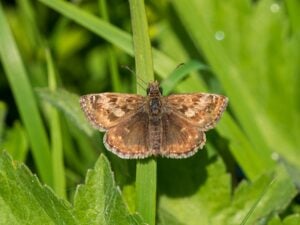Vulnerable butterfly species thrives at Forterra’s Kirton conservation site

This World Environment Day (5th June), Forterra is celebrating the presence of a vulnerable butterfly species, the dingy skipper, which has found a home at the company’s Kirton Brickworks site in Nottinghamshire.
Forterra has worked with ecologists since 2007 to monitor and manage biodiversity across several of its sites across the country – and thanks to a long-term restoration and habitat management plan developed during the Kirton site’s planning stages, a colony of dingy skippers has taken hold along a disused railway line that runs through the site.
The Kirton site is home to a rich variety of invertebrates, including several butterflies such as green hairstreaks, common blue butterflies, and brown argus butterflies. But because the dingy skipper is especially dependent on specific environmental conditions, it is particularly vulnerable, because unlike other butterflies, it only flies during warm, sunny spells and relies on bare ground to bask, making it highly sensitive to changes in vegetation.
Ecologists found that without intervention, the habitat would have scrubbed over, ultimately leading to the colony’s disappearance. Forterra’s ecological advisor, Phil Parker, explains, “In most parts of Britain, unmanaged land gradually reverts to woodland: lakes dry out, grasslands vanish. But it’s precisely this habitat that species like the dingy skipper rely on. Quarry sites like Kirton offer that rare opportunity to preserve these conditions.”
Forterra follows a detailed management plan to maintain the habitat, which includes regular scrub clearance, mowing, and the scraping back of soil to expose basking areas. These actions not only benefit the dingy skipper, but also support other grassland species and reptiles that move along railway corridors.
“Populations are monitored every three years,” adds Phil, “and this allows the team to adapt its management practices. An ecosystem, even a small one, exists in a very delicate balance. Following a cool wet spring in 2024, insect numbers in general and dingy skipper numbers, in particular, struggled.
“The warm spring weather in 2025 has been more conducive to invertebrates and although they have not recovered to their former numbers, there are signs of a recovery of a range of species including the dingy skipper. This all illustrates how finely balanced habitats and species area and how important it is that they are looked after and appropriately managed.”
Historically, the dingy skipper was rare in Nottinghamshire, mostly confined to derelict railway lines by 2003. But thanks to restored mineral sites like Kirton, it is now beginning to recolonise wider areas across the county. Forterra’s work reflects a growing awareness across the industry of the importance of sustainability and habitat creation on former brownfield land.
Tim Darling, Head of Land and Mineral Resources at Forterra, said: “Quarry restoration gives us a unique chance to enhance biodiversity in ways that wouldn’t otherwise happen. At Kirton, we’ve been able to support a nationally vulnerable species, which is something we’re proud of and are striving to improve on at other sites within the business.”
Kirton is just one of several Forterra sites making headlines for biodiversity. In 2018, at Kings Dyke Nature Reserve in Whittlesey, Peterborough, a 24-hour BioBlitz led by Chris Packham from BBC’s Springwatch, recorded 1,138 species, more than any other site surveyed nationwide, including national nature reserves. A BioBlitz has been carried out each year since and another is planned for this Autumn.
For more information about Forterra’s environmental initiatives, visit out sustainability page
